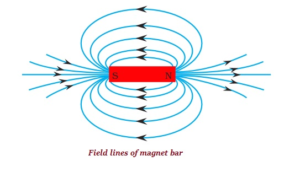Table of Contents
Electric current has three distinct effects. There are three of them: magnetic effect, heating effect, and chemical effect. When an electric current flows through a wire, a magnetic field is created around the wire, which can be measured using a compass. The magnetic field has a magnitude and a direction. If the electric current flows north to south, the magnetic compass will deflect clockwise, implying that the direction of the magnetic field is dependent on the direction of the electric current. Magnetic lines are thought to emerge from the north pole and merge at the south pole. Two magnets’ magnetic field lines cannot intersect. The magnitude of the magnetic field increases as the electric current through the wire increases. Tesla is the SI unit for the magnetic field. Electricity and magnetism are inextricably linked, and it has been demonstrated that when an electric current passes through a copper wire, it produces a magnetic effect.
Magnetic Field
The magnetic field is a quantity with both magnitude and direction. The direction of a magnetic field is usually taken to be the direction in which the north pole of a compass needle travels within it. The field lines are supposed to emerge from the north pole and merge at the south pole. There are no two-magnet bar field lines that cross each other. If this happens, the compass needle will point in two directions at the intersection, which is not possible. The magnitude of the magnetic field produced by an electric current at a given point increases as the current through the wire increases.
A magnetic field is a force field formed by magnetic dipoles and moving electric charges that exerts force on other nearby moving charges and magnetic dipoles. Because it has both magnitude and direction, magnetic field is a vector quantity.
A straight current-carrying conductor is surrounded by a magnetic field formed by concentric circles. Magnetic field lines can be used to depict the magnetic field of a straight current-carrying conductor. The direction of a magnetic field produced by a current-carrying conductor is determined by the direction of the current. If the direction of the electric current changes, the direction of the electric field reverses.

Right-Hand Thumb rule
The “right-hand thumb rule” is a simple way to remember the order of operations for mathematical operations. The rule is that you should do operations in the order of parentheses, exponents, multiplication and division (from left to right), and addition and subtraction (from left to right). The thumb of your right hand can be used to help remember this order, with the thumb pointing in the direction of the operation to be performed.
Fleming’s Left-Hand Rule
“Stretch the left thumb, forefinger, and middle finger to be perpendicular to each other,” says Fleming’s left-hand rule. The thumb points in the direction of motion or the driver’s force if the first finger points in the direction of the magnetic field and the second finger in the direction of the current.” The magnetic field produced by the human body is also minimal, accounting for about one billionth of the magnetic field on Earth. The magnetic field was created by the two main organs in the human body, the heart and the brain. The magnetic field within the human body serves as the foundation for obtaining images of various body parts.
FAQs
What does the Magnetic Effect of Electric Current mean?
The term magnetic electrical current effect' implies that an electrical current flowing through a wire creates a magnetic field around it.
What Are the Two Effects of Electricity?
Electric current has two effects: heating and magnetic attraction. This occurs because an electric current passing through a conductive wire generates a magnetic field around it. The magnetic compass deflects as a result of the magnetic field.







